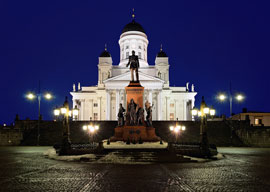
December 04, 2013

Helsinki Cathedral and monument to Alexander II, Finland
Source: Shutterstock
What’s going on? Most of Eric’s classmates spend from 8AM to 9PM at school, primarily test prepping, then go to private hagwon cram schools until curfew at 11PM. They nap through the day on the assumption that school is less important than evening test prep:
He had found one possible explanation for Korea’s PISA scores, and it was depressing. Kids learned a lot, but they spent a ridiculous amount of time doing so….He was astounded by the inefficiency of it all. In Korea, school never stopped.
Ripley doesn’t mention another reason Koreans tend to score well on tests: organized cheating. For example, a recent SAT test was called off because the test booklet was being sold in Korea for thousands of dollars.
In contrast, Finnish education is famously laid-back. It’s the anti-Korea. This Nordic country is the closest thing to a real-life Lake Wobegon, where all the children are above average. Students don’t start first grade until age seven, aren’t given enormous amounts of homework, aren’t tested often, and don’t test-prep much at all. Finland doesn’t pay schoolteachers all that much in money, but they are respected, both in the culture and (crucially) in the classroom.
Finnish teachers are instructed to keep the left half of the bell curve up to speed so they don’t drag down the class, while the smarter kids are expected to read ahead in the textbook on their own. Whether this would work in the US, where the bell curve is wider and the students less disciplined and cooperative, is another question.
But the Finns have a system that works well for Finns, and good for them.
Polish schooling isn’t anything special, but it has by all accounts improved significantly since the 1990s. Considering what a mess communism left in Eastern Europe, the rapidity with which Poland has been progressing toward “normal country” status is impressive.
What do Finland, Poland, and South Korea have in common?
First, all three achieved their independence only within the last 100 years, and they were each invaded at Stalin’s command in 1939-1950. They remain relatively patriotic in the old-fashioned nationalist modernizer mode that did so much to lift educational levels beginning in Prussia. They see education as a way for their people to get ahead in the world.
In contrast, India”even though it is always grouped with China in President Obama’s rhetoric about America’s main educational rivals”has dropped out of the PISA after a disastrous trial run in which two Indian states performed at sub-Saharan levels. India has been the darling of Davos Man for its seeming postmodern post-nationalism, but unfashionable old nationalism retains the best track record at uplifting the masses.
Second, none of the three had colonies and therefore don’t feel any imperial guilt.
Third, the three countries have very few students of first- or second-generation immigrant background. A recent PISA study showed Finland’s student body is only 3 percent non-Finnish (compared to 19 percent immigrant in the US), while Poland’s and South Korea’s immigrant percentages rounded down to zero.
Ripley visits a Finnish school that has many immigrants and breathlessly reports that everybody is above average. In reality, children of immigrants score well over a half standard deviation below average in Finland. And the three largest sources of immigrants in Finland remain neighboring Estonia, Russia, and Sweden.
In 2009, immigrants dragged down average PISA scores in almost all countries except Australia, which works hard to keep out illegal immigrants and uses a points system to help pick promising legal ones.
Fourth, even though Ripley is excited to see some Somalis in one Finnish school, none of these countries has many blacks. What giant pandas are to the cause of biodiversity preservation, blacks are to the reigning dogma of diversity: “charismatic megafauna.” Thus, not only do blacks tend to lower test scores and disrupt classrooms, they also tend to warp elite thinking and public policy.
For example, the Obama Administration has been persecuting local school districts that suspend higher percentages of black students. Now, you know and I know and even Barack Obama knows that the reason for this is because on average black students cause more trouble. But in America today you aren’t supposed to know that, so the federal government is pushing a policy on school districts: If they want to stay out of trouble with the feds, they should ignore black troublemakers.
This won”t do the non-troublemakers in the classroom much good, but who cares about them? If the students who just wish to learn want the federal government’s concern, they”ll need to become charismatic megavictims too. The important thing in 2013 America is to hunt down all those white racist schoolteachers and administrators who cause The Gap.
How that will help get us to Finnish levels of classroom order and quality teachers remains a puzzle.